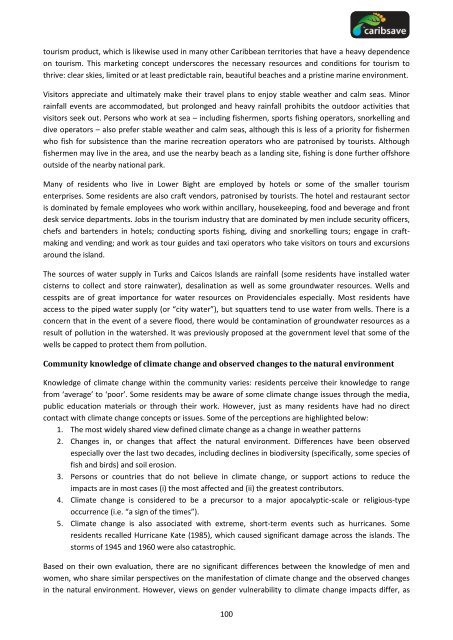You also want an ePaper? Increase the reach of your titles
YUMPU automatically turns print PDFs into web optimized ePapers that Google loves.
tourism product, which is likewise used in many other Caribbean territories that have a heavy dependence<br />
on tourism. This marketing concept underscores the necessary resources <strong>and</strong> conditions for tourism to<br />
thrive: clear skies, limited or at least predictable rain, beautiful beaches <strong>and</strong> a pristine marine environment.<br />
Visitors appreciate <strong>and</strong> ultimately make their travel plans to enjoy stable weather <strong>and</strong> calm seas. Minor<br />
rainfall events are accommodated, but prolonged <strong>and</strong> heavy rainfall prohibits the outdoor activities that<br />
visitors seek out. Persons who work at sea – including fishermen, sports fishing operators, snorkelling <strong>and</strong><br />
dive operators – also prefer stable weather <strong>and</strong> calm seas, although this is less of a priority for fishermen<br />
who fish for subsistence than the marine recreation operators who are patronised by tourists. Although<br />
fishermen may live in the area, <strong>and</strong> use the nearby beach as a l<strong>and</strong>ing site, fishing is done further offshore<br />
outside of the nearby national park.<br />
Many of residents who live in Lower Bight are employed by hotels or some of the smaller tourism<br />
enterprises. Some residents are also craft vendors, patronised by tourists. The hotel <strong>and</strong> restaurant sector<br />
is dominated by female employees who work within ancillary, housekeeping, food <strong>and</strong> beverage <strong>and</strong> front<br />
desk service departments. Jobs in the tourism industry that are dominated by men include security officers,<br />
chefs <strong>and</strong> bartenders in hotels; conducting sports fishing, diving <strong>and</strong> snorkelling tours; engage in craftmaking<br />
<strong>and</strong> vending; <strong>and</strong> work as tour guides <strong>and</strong> taxi operators who take visitors on tours <strong>and</strong> excursions<br />
around the isl<strong>and</strong>.<br />
The sources of water supply in <strong>Turks</strong> <strong>and</strong> <strong>Caicos</strong> Isl<strong>and</strong>s are rainfall (some residents have installed water<br />
cisterns to collect <strong>and</strong> store rainwater), desalination as well as some groundwater resources. Wells <strong>and</strong><br />
cesspits are of great importance for water resources on Providenciales especially. Most residents have<br />
access to the piped water supply (or “city water”), but squatters tend to use water from wells. There is a<br />
concern that in the event of a severe flood, there would be contamination of groundwater resources as a<br />
result of pollution in the watershed. It was previously proposed at the government level that some of the<br />
wells be capped to protect them from pollution.<br />
Community knowledge of climate change <strong>and</strong> observed changes to the natural environment<br />
Knowledge of climate change within the community varies: residents perceive their knowledge to range<br />
from ‘average’ to ‘poor’. Some residents may be aware of some climate change issues through the media,<br />
public education materials or through their work. However, just as many residents have had no direct<br />
contact with climate change concepts or issues. Some of the perceptions are highlighted below:<br />
1. The most widely shared view defined climate change as a change in weather patterns<br />
2. Changes in, or changes that affect the natural environment. Differences have been observed<br />
especially over the last two decades, including declines in biodiversity (specifically, some species of<br />
fish <strong>and</strong> birds) <strong>and</strong> soil erosion.<br />
3. Persons or countries that do not believe in climate change, or support actions to reduce the<br />
impacts are in most cases (i) the most affected <strong>and</strong> (ii) the greatest contributors.<br />
4. Climate change is considered to be a precursor to a major apocalyptic-scale or religious-type<br />
occurrence (i.e. “a sign of the times”).<br />
5. Climate change is also associated with extreme, short-term events such as hurricanes. Some<br />
residents recalled Hurricane Kate (1985), which caused significant damage across the isl<strong>and</strong>s. The<br />
storms of 1945 <strong>and</strong> 1960 were also catastrophic.<br />
Based on their own evaluation, there are no significant differences between the knowledge of men <strong>and</strong><br />
women, who share similar perspectives on the manifestation of climate change <strong>and</strong> the observed changes<br />
in the natural environment. However, views on gender vulnerability to climate change impacts differ, as<br />
100





